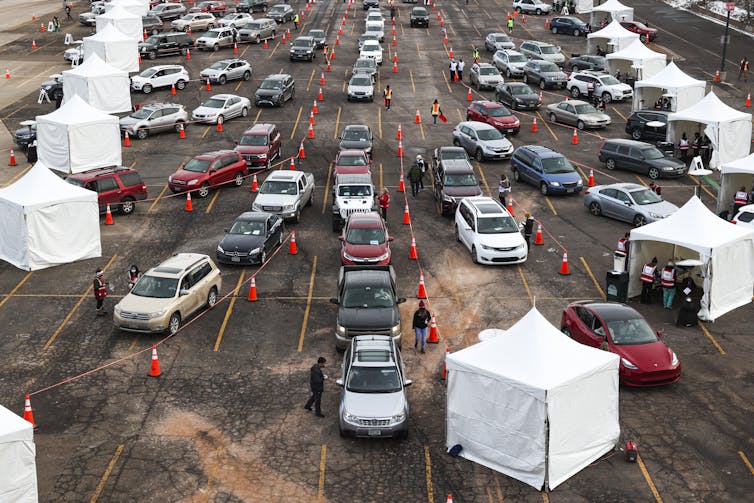What a squeezed rubber ducky suggests about the lingering effects of vaccine misinformation
Vaccine hesitancy will not go away fast. In fact, there are parallels in the physical world to how quickly or slowly an object returns to its normal state.

The mutations in the coronavirus indicate that the virus is working hard to survive, with transmissible COVID-19 variants being detected around the world. These mutations have increased the urgency of vaccinating hundreds of millions of people within a matter of months. While that work has been stymied by governmental missteps, vaccine resistance could ultimately be the biggest hurdle to reaching herd immunity.
And yet, we find hope in a rubber duck – or at least in the way a squeezed duck returns to its normal state. We have found that changing people’s beliefs about vaccines is going to take time, the way a deflated rubber duck springs back slowly after being squeezed. However much we’d love to cast Harry Potter’s “Reparo” charm and make vaccine hesitancy flick away instantly, we need to work hard at it.
Our research in the Fu lab at Dartmouth College focuses on the principles that govern dynamics of evolving systems across different domains and at different scales. Our current research combines game theory models of vaccination behavior with an epidemiological process to provide insight into the vaccination compliance problem. We have found that the same effect that causes the delayed recovery of a squeezed rubber duck – the hysteresis effect – can appear as an unforeseen roadblock for the recovery of vaccination rates. While vaccination has long met resistance, some experts point to a 1982 television documentary about vaccination for diphtheria, pertussis and tetanus that led to the deep skepticism about vaccines today.
How a physical property can also apply to social factors
The term “hysteresis” is derived from ὑστέρησις, an ancient Greek word meaning “lagging behind.” It was coined by Sir James Alfred Ewing to describe the behavior of magnetic materials. Iron maintains some magnetization after it has been exposed to and removed from a magnetic field.
The phenomenon also occurs in other systems that have memory. In economics, it refers to economic events that persist into the future, even after the triggers have been removed. It is why unemployment rates may continue to climb despite a recovering economy following a recession.
Such history dependence can be caused by the physical properties of an object or the biological functions of an organism, and in other cases it is due to social or psychological factors.
A more endearing example is the rubber duck. When a child squeezes a rubber duck, it will change shape. Even after the child releases the duck, it will not spring back quickly.
Whether in the science lab, business hub or bathtub, the effects of hysteresis are easy to see. And it is the same force coming into play around vaccination campaigns.
Hysteresis in public health
We discovered for the first time the hysteresis effect and the existence of a hysteresis loop in the context of public health and vaccine behavior in a 2019 research paper. The hysteresis loop can be caused by concerns related to the effectiveness and perceived risk of vaccines. Negative experiences or perceptions related to vaccination affect the trend of uptake and cause the “vaccination trajectory” to get stuck in a hysteresis loop.
Imagine, again, our squeezed rubber duck. Mistrust in vaccines – no matter how unfounded – causes an increase in the perceived risk of vaccination. This hinders the growth of the vaccine uptake rate – as the duck is deformed. People may still resist vaccination even after misinformation has been corrected. The rubber duck will not spring back instantly, no matter how demanding the child.
The result is clear: Not only are vaccination rates impaired by rumors in the immediate term, but recovering public confidence takes an extended time.

Vaccine compliance
Our results have practical implications for improving vaccine compliance by overcoming the hysteresis effect.
The data from the Centers for Disease Control and Prevention shows that over 50 million doses of COVID-19 vaccines have been distributed in the U.S., whereas merely 6 million people have completed the vaccination process.
Although not the only reason for the sluggish vaccination drive, mistrust is slowing the process. Questions about mRNA vaccines make people skeptical of getting them. Some health care personnel and front-line essential workers themselves are declining to be vaccinated.
Indecision and hesitancy are the tight fist that squeezes the rubber duck. Publicizing vaccine knowledge and accelerating the distribution process is more vital than ever if we want to loosen the grip that is complicating vaccination efforts.
For fact-checked information on the COVID-19 vaccines, public health officials should continue to promote reliable sources including the website of the CDC and the World Health Organization. Social media-ready vaccine content, too, is being leveraged to effectively communicate with the audience and combat misinformation across platforms such as Twitter and Facebook.
For residents waiting anxiously for their turn, a user-friendly registration portal and an easy appointment are needed to accelerate the distribution process. A leftover dose should be given to anyone who wants it, regardless of his or her priority, to prevent vaccines from expiring and going wasted.
Herd immunity and altruistic behavior
Vaccination hesitance is just one example of human cooperation problems in the real world. To avoid the tragedy of the commons, which says, essentially, that people pursue their own needs at the expense of others’, the U.S. needs cooperative and collective action. An individual’s vaccination contributes to herd immunity, where people who are not immune are indirectly protected if most of the population is immune to an infectious disease.
To improve vaccine compliance and achieve herd immunity with COVID-19 expeditiously, the U.S. should overcome the hysteresis effect by reducing the resistance to vaccination. In particular, vaccination campaigns should promote vaccination as an altruistic behavior that has tremendous societal benefit. By getting vaccinated, we protect not only family members, friends and colleagues, but also strangers, including those who cannot be vaccinated, like newborns.
To embrace a quick “back to normal,” the U.S. cannot help but rely on a prompt and effective mass vaccination before it is too late to control new virus variants. It has already taken a herculean effort to develop, distribute and administer the vaccines. Now it is time to help the rubber duck return to form.
[Get facts about coronavirus and the latest research. Sign up for The Conversation’s newsletter.]
Feng Fu receives funding from the National Institutes of Health and the Gates Foundation.
Xingru Chen does not work for, consult, own shares in or receive funding from any company or organisation that would benefit from this article, and has disclosed no relevant affiliations beyond their academic appointment.
Read These Next
West Antarctica’s history of rapid melting foretells sudden shifts in continent’s ‘catastrophic’ geo
A picture of what West Antarctica looked like when its ice sheet melted in the past can offer insight…
The celibate, dancing Shakers were once seen as a threat to society – 250 years later, they’re part
‘The Testament of Ann Lee,’ Mona Fastvold’s 2025 film, depicts part of the long history of Shaker…
As DOJ begins to release Epstein files, his many victims deserve more attention than the powerful me
Powerful men connected to Jeffrey Epstein are named, dissected and speculated about. The survivors,…






